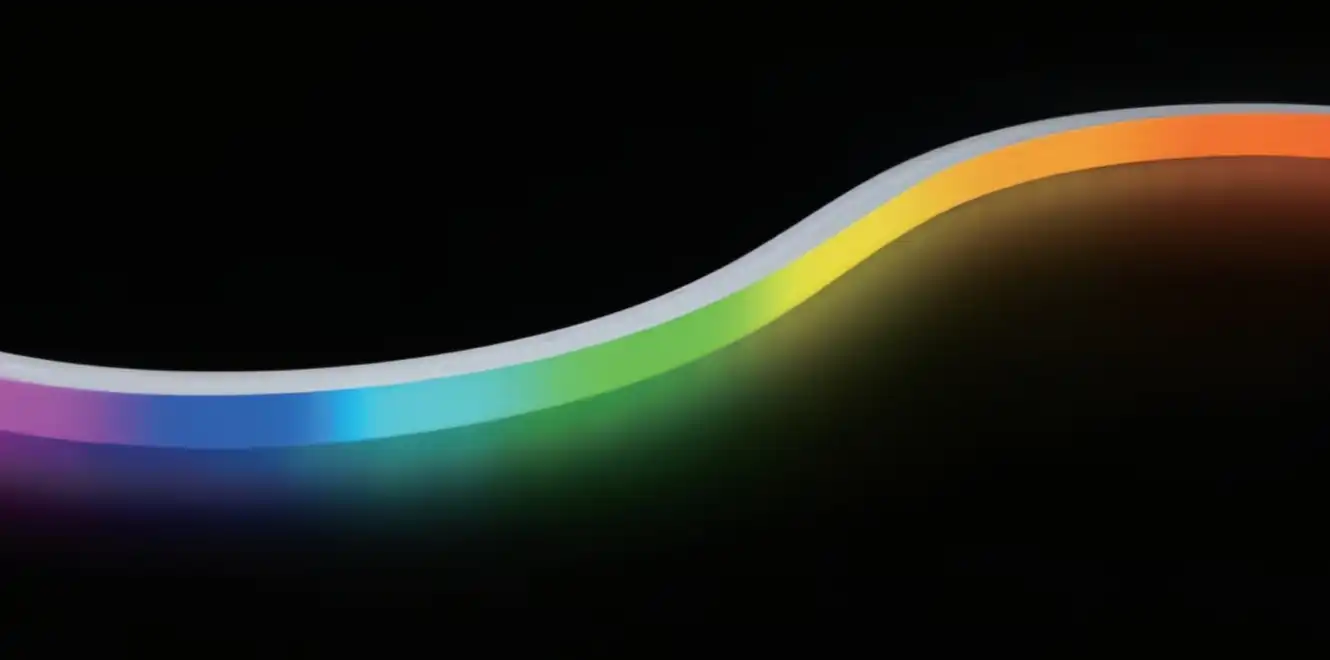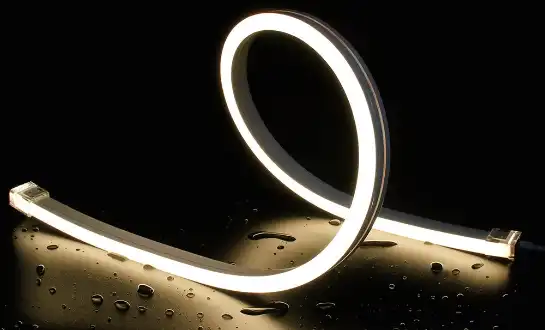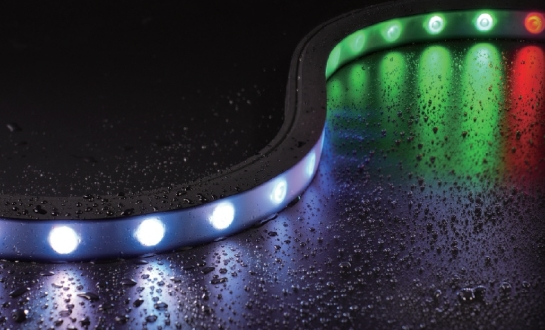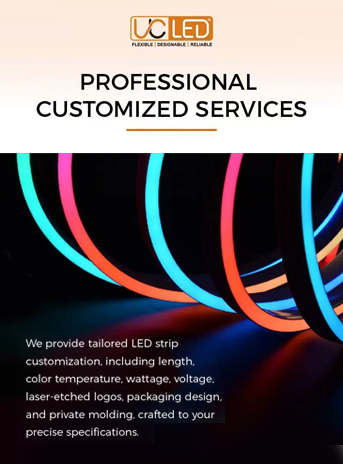Understanding Flexible LED Neon Strips and Dimming Technology
Flexible LED neon strips have revolutionized the lighting industry, offering versatile and energy-efficient illumination solutions for various applications. These innovative lighting products combine the flexibility of traditional neon lights with the advantages of LED technology, resulting in a unique and captivating lighting option.
To fully grasp the compatibility of flexible LED neon strips with dimmers, it's essential to understand the core components and technology behind these lighting systems:
Components of Flexible LED Neon Strips
Flexible LED neon strips consist of several key components:
- LED chips: These are the primary light-emitting elements.
- Flexible PCB: A bendable circuit board that houses the LED chips.
- Silicone or PVC casing: A protective and flexible outer layer that gives the strip its neon-like appearance.
- Connectors and wiring: These allow for power supply and control connections.
The unique construction of flexible LED neon strips allows them to emulate the look of traditional neon lights while offering superior energy efficiency, durability, and flexibility in installation.
Dimming Technologies for LED Lighting
Several dimming technologies are commonly used with LED lighting systems:
- Pulse Width Modulation (PWM): This method rapidly switches the LEDs on and off to create the illusion of dimming.
- Constant Current Reduction (CCR): This technique reduces the current flowing through the LEDs to lower their brightness.
- 0-10V dimming: A control method that uses a varying voltage signal to adjust brightness levels.
- TRIAC dimming: Originally designed for incandescent lights, this method has been adapted for some LED systems.
The compatibility of flexible LED neon strips with these dimming technologies largely depends on the LED driver and control circuitry used in the system.
Factors Affecting Dimming Compatibility
Several factors influence whether a flexible LED neon strip can be successfully dimmed:
- LED driver type: The driver must be compatible with the chosen dimming method.
- Control circuitry: The strip's internal circuitry must be designed to handle dimming signals.
- Power supply: The power supply must be able to maintain stable output across different dimming levels.
- Dimmer compatibility: Not all dimmers are suitable for LED lighting, and some may cause flickering or inconsistent performance.
Understanding these factors is crucial for selecting the right flexible LED neon strip for your dimming needs and ensuring optimal performance.
Assessing Dimmer Compatibility with Flexible LED Neon Strips
When considering the use of dimmers with flexible LED neon strips, it's important to conduct a thorough assessment to ensure compatibility and optimal performance. This evaluation process involves several key steps and considerations:
Checking Manufacturer Specifications
The first and most crucial step in assessing dimmer compatibility is to carefully review the manufacturer's specifications for the flexible LED neon strip. Look for the following information:
- Dimming capability: Check if the product is explicitly labeled as dimmable.
- Supported dimming methods: Identify which dimming technologies are compatible with the strip.
- Recommended dimmers: Some manufacturers provide a list of tested and approved dimmers.
- Minimum and maximum dimming range: This indicates the extent to which the strip can be dimmed without issues.
If the manufacturer's specifications are unclear or incomplete, don't hesitate to contact their technical support team for clarification.
Evaluating Existing Dimming Systems
If you're planning to use flexible LED neon strips with an existing dimming system, it's essential to evaluate its compatibility:
- Identify the type of dimmer currently installed (e.g., TRIAC, 0-10V, or PWM).
- Check if the dimmer is designed for LED lighting or if it's an older model intended for incandescent bulbs.
- Assess the dimmer's load capacity to ensure it can handle the power requirements of the LED neon strip.
- Consider any potential interference from other lighting or electrical systems in the same circuit.
In some cases, you may need to upgrade or replace your existing dimming system to achieve compatibility with flexible LED neon strips.
Testing and Troubleshooting
Even with careful planning, it's advisable to conduct practical tests before full installation:
- Perform a small-scale test with a short section of the flexible LED neon strip and the intended dimmer.
- Observe the dimming performance across the entire range, from full brightness to the lowest setting.
- Look for any signs of flickering, inconsistent brightness, or sudden cutoffs at low dimming levels.
- If issues arise, try adjusting the dimmer's settings or consult with a lighting professional for advanced troubleshooting.
This testing phase can help identify any potential compatibility issues early on, saving time and resources in the long run.
Optimizing Dimming Performance for Flexible LED Neon Strips
Once you've confirmed compatibility between your flexible LED neon strips and dimming system, the next step is to optimize the dimming performance. This optimization process ensures smooth, flicker-free operation and extends the lifespan of your lighting installation.
Selecting the Right LED Driver
The LED driver plays a critical role in the dimming performance of flexible LED neon strips. Consider the following when choosing an LED driver:
- Dimmable rating: Ensure the driver is specifically designed for dimming applications.
- Compatibility with your chosen dimming method (e.g., PWM, 0-10V, TRIAC).
- Power output matching the requirements of your LED neon strip installation.
- Quality and reliability: Opt for drivers from reputable manufacturers to ensure consistent performance.
A well-matched LED driver can significantly improve dimming quality and reduce issues like flickering or inconsistent brightness levels.
Fine-tuning Dimmer Settings
Many modern dimmers offer adjustable settings that can be fine-tuned for optimal performance with LED lighting:
- Minimum brightness level: Adjust this setting to prevent cutoff at low dimming levels.
- Dimming curve: Some dimmers allow you to customize the dimming curve to match LED characteristics.
- Fade time: Adjust the transition speed between brightness levels for smoother dimming.
- Presets: Set up frequently used brightness levels for convenient access.
Experimenting with these settings can help achieve the desired dimming effect and improve overall user experience.
Addressing Common Dimming Issues
Even with compatible components, you may encounter some dimming issues. Here are some common problems and potential solutions:
- Flickering: This can often be resolved by using a higher-quality dimmer or adjusting the minimum brightness setting.
- Limited dimming range: Try a different dimming technology or upgrade to a more compatible LED driver.
- Inconsistent brightness across multiple strips: Ensure all strips are using the same type of LED driver and are properly synchronized.
- Electromagnetic interference: Use shielded cables and proper grounding techniques to minimize interference.
If problems persist, consult with a lighting professional or the manufacturer's technical support team for advanced troubleshooting and solutions.
Regular Maintenance and Monitoring
To maintain optimal dimming performance over time:
- Periodically check connections and ensure all components are securely fastened.
- Monitor for any signs of degradation in dimming quality or responsiveness.
- Keep the lighting system clean and free from dust or debris that could affect performance.
- Stay informed about firmware updates for smart dimming systems that may improve compatibility or add new features.
By following these optimization strategies, you can ensure that your flexible LED neon strips provide smooth, reliable dimming performance for years to come.
Conclusion
In conclusion, while not all flexible LED neon strips are inherently compatible with dimmers, many modern options do offer dimming capabilities. The key to successful integration lies in careful selection, proper assessment, and optimization of both the LED strips and the dimming system. By understanding the technology behind these innovative lighting solutions and following the guidelines outlined in this article, you can create stunning, adjustable lighting installations that combine the unique aesthetic of neon with the efficiency and versatility of LED technology.
Remember that compatibility issues can often be resolved through proper component selection, fine-tuning, and professional guidance. As the technology continues to evolve, we can expect even greater compatibility and more advanced dimming options for flexible LED neon strips in the future. Whether you're planning a residential accent lighting project or a large-scale commercial installation, taking the time to ensure dimmer compatibility will result in a more satisfying and functional lighting experience.
FAQ
Can I use any dimmer with flexible LED neon strips?
No, not all dimmers are compatible. It's essential to use dimmers specifically designed for LED lighting and check compatibility with your specific LED neon strip model.
What should I do if my LED neon strip flickers when dimmed?
Flickering can often be resolved by using a higher-quality LED-compatible dimmer, adjusting the minimum brightness setting, or upgrading the LED driver.
Are there any risks in using incompatible dimmers with LED neon strips?
Yes, using incompatible dimmers can lead to poor performance, reduced lifespan of the LEDs, and in some cases, damage to the lighting system or dimmer.
Experience the Brilliance of Dimmable Flexible LED Neon Strips | QUAN HE
At QUAN HE Lighting Co., Ltd., we specialize in crafting premium, dimmable flexible LED neon strips that seamlessly integrate with various dimming systems. Our state-of-the-art manufacturing facility and expert R&D team ensure top-quality, customizable lighting solutions for any project. Experience the perfect blend of innovation and reliability with our UL, CE, and ROHS certified products. For tailored lighting solutions that illuminate with precision, contact us at Linda@uc-led.com.
References
1. Johnson, M. (2022). "Advanced LED Dimming Technologies: A Comprehensive Guide." Lighting Research and Technology, 54(3), 245-260.
2. Smith, R. and Brown, L. (2021). "Compatibility Issues in LED Neon Strip Dimming: Causes and Solutions." Journal of Illuminating Engineering Society, 17(2), 78-92.
3. Zhang, Y. et al. (2023). "Optimizing Dimmer Performance for Flexible LED Neon Installations." IEEE Transactions on Industry Applications, 59(4), 3215-3228.
4. Anderson, K. (2022). "The Evolution of Flexible LED Neon Technology: From Fixed to Dimmable." Lighting Design and Application, 52(6), 42-55.
5. Lee, S. and Park, J. (2023). "Comparative Analysis of Dimming Methods for LED Neon Strips in Architectural Lighting." Building and Environment, 215, 109262.







